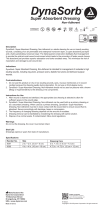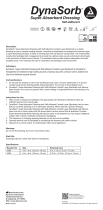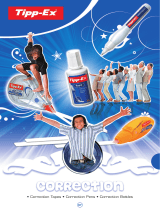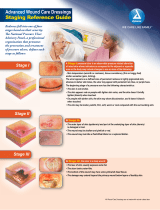
Skin & Wound Care Division
3M Health Care
3M Center, Building 275-4W-02
St. Paul, MN 55144-1000
U.S.A.
1-800-228-3957
www.3M.com/healthcare
3M Canada
P.O. Box 5757
London, Ontario N6A4T1
Canada
1-800-563-2921
www.3M.com/ca/healthcare
3M is a trademark of 3M.
Please recycle.
© 3M 2004, 2010. All rights reserved.
70-2008-6377-0
Two Common Taping Concerns
Tape doesn’t stick? The problem might be: Skin Damage? The problem might be:
Skin
preparation
• Damp or oily skin
• Prep solution containing surfactant or glycerin was
not allowed to dry
• Vigorous alcohol prep
• Sensitivity to tackier
• Skin irritated/denuded before tape applied
Application/
removal
technique
• Tape not gently and rmly stroked after applying
• Gaps left between tape and tubing/dressing
• Loose tape edges
• “Folded tab” left on tape
• Tubing subjected to tension/pulling
• Tape applied under tension
• Traumatic removal
• Tape removed at an angle
• Skin not supported during removal
• Too much tape
• Area completely encircled with tape
Choice of tape
• Adhesive not strong enough for the particular
application, for example:
–very active patient
–patient pulls at tubing/dressing
–heavy device or tubing
–lacking tension loop
–“critical” application
• Tape too stiff to conform to contours
• Inappropriate tape for degree of skin moisture or surface
of dressing/device
• Adhesion may vary depending on skin type and body
chemistry; if one tape doesn’t adhere, consider
selecting another 3M medical tape
• “Non-stretch” tape used on area that “expanded”
(e.g., edema, hematoma formation, distention) or moved
• Adhesive more aggressive than needed
• Occlusive tape left on too long
• Patient sensitive to specic adhesive
• Irritating tape or substance placed over perforated or porous tape
3M
™
Medical Tapes
Trouble-Free Taping
3M shares in your passion and dedication to provide the best health care for your patients.
For over 50 years, we have partnered with health care professionals to provide innovative,
high-quality skin and wound care products and a full range of educational tools to support
you in their use.
Education tools available on our website include: the Tape with Care Continuing Education
program, Choosing the Right Tape for the Right Application product selection guide, product
training, and other clinical resources. To learn more, visit www.3M.com/medicaltapes and
click on the Continuing Education link.
Tips for
For more information, visit us at www.3M.com/medicaltapes,
contact your 3M Health Care Sales Representative or call the
3M Health Care Customer Helpline at 1-800-228-3957.
These products can be ordered from your local distributor.
Outside the United States, contact the local 3M subsidiary.

Problem Cause To reduce the risk of injury
Stripping
A partial thickness injury occurring when adhesive
bond between tape and skin is greater than the bond
between epidermis and dermis. As tape is removed, the
epidermis remains attached to the adhesive, resulting in
epidermal damage or a painful area of exposed dermis.
Degree of stripping varies with skin condition, adhesive
characteristics, and frequency of taping.
• Use gentle, hypoallergenic tape
• Match strength of adhesive to clinical needs and skin condition
• Apply tape to clean, dry skin
• For high risk patients, avoid using skin tackiers under tape
• Protect skin with 3M™ Cavilon™ No Sting Barrier Film
allowing it to dry before taping
• If repeated taping is anticipated, consider applying tape over a platform
• Use proper removal technique
Mechanical
Injury Due To
Tension
The most common causes of tension injury are
inappropriate strapping of tape during application and
distention of skin under an unyielding tape. Strapping tape
across skin is mistakenly thought to increase adhesion.
As the tape backing resists stretch or regains its original
shape, the epidermis begins to lift. This results in “tension
blisters” typically seen at ends of the tape. Skin tears may
occur before a blister even forms. Tension injuries may
also occur when edema, hematoma formation, or distention
distorts the skin surface or when a joint or other area of
movement is covered with an unyielding tape.
• Apply tape without tension
• Identify patients at high-risk: fragile skin, medical conditions
(e.g., long-term corticosteroid use, malnutrition) or surgical
procedures where edema or distention is expected (abdominal,
orthopedic)
• Protect skin with 3M™ Cavilon™ No Sting Barrier Film
• If swelling or movement is expected, use a tape that stretches. Apply
tape so direction of stretch corresponds with direction of swelling
• If desired, compression may be obtained by carefully stretching tape
over a dressing while securing the tape to the skin without tension.
• If distention or edema is noted, loosen, reposition, or replace tape
Non-Allergic
Contact Dermatitis
A non-allergic contact dermatitis may result when chemical
irritants such as tackiers or some skin preparations are
trapped between adhesive and skin. The affected area will
correlate to the area of exposure and may appear reddened,
swollen, blistered, or weeping.
• Assure that skin is clean and dry before applying tape
• Protect skin with 3M™ Cavilon™ No Sting Barrier Film allowing
it to dry before applying tape
• If possible, avoid using tackiers
Allergic Contact
Dermatitis
Allergic reactions are cell-mediated immunologic responses
to a particular component of a tape adhesive or backing
and occur infrequently. Patients may be mistakenly
identied as having tape allergies when, in fact, they have
experienced a non-allergic contact dermatitis. Clinical signs
include well-dened areas of erythema and edema;
vesicles may be present, as well as small erosions.
• Identifying type of tape causing sensitivity
• Options may include identifying an alternative hypoallergenic tape
or contacting tape manufacturer for assistance
• Using 3M™ Cavilon™ No Sting Barrier Film may not prevent an
allergic reaction
Folliculitis
Folliculitis is an inammation of the hair follicle caused by
shaving or entrapment of bacteria.
• Use a clipper or depilatory preparation if hair removal is necessary
Maceration
Maceration refers to skin changes seen when moisture is
trapped against the skin for a prolonged period. The skin will
turn white or gray, softens and wrinkles. Macerated skin is
more permeable and prone to damage from friction and
irritants.
• Keep taped skin clean and dry
• Replace tape if soiled
• Use breathable tape in moist areas
• Avoid occlusive tapes unless clinically indicated
Tape Application Reducing The Risk Of Superficial Skin Damage Related To Adhesive Use
Tape and Transparent Dressing Removal
A. General taping
Apply the tape without tension, gently but firmly stroking the surface to maximize adhesion. Tape should extend
at least one-half inch beyond the dressing. Tape should not be pulled or stretched when applied. If swelling does
occur, loosen and re-fasten or replace tape to relieve the tension.
C. When distention is anticipated
Foam tapes generally stretch in all directions; however, non-woven soft cloth tapes, such as 3M™ Medipore™
Soft Cloth Tape, and 3M™ Medipore™ H Soft Cloth Tape have more stretch in the cross-direction and on the bias.
The direction of the stretch should be considered when securing a dressing or tubing to an area that is at high risk
for distention, edema, hematoma formation, or movement. Anecdotally, applying soft cloth tape parallel to the
incision appears to be associated with fewer skin tension injuries than taping perpendicular to the incision.
A. Tape strips
1. Loosen edges of tape. If necessary, press a small piece of tape onto a corner to start an edge of the tape.
2. Stabilize the skin with one finger. Remove tape “low and slow” in direction of hair growth, keeping
it close to skin surface and pulled back over itself. Removing tape at an angle will pull at the epidermis
increasing risk of mechanical trauma. As tape is removed, continue supporting newly exposed skin.
B. 3M™ Tegaderm™ Transparent Dressing
• Tape should be applied without tension to clean, dry skin.
• A clipper may be used to remove hair, if necessary.
• To protect at-risk skin, 3M™ Cavilon™ No Sting Barrier Film may be applied and when thoroughly dry, tape may be applied over it.
• In general, do not encircle a limb completely with tape.
• If distention is anticipated, use a tape that stretches or a self-adherent wrap to secure the dressing or tubing.
Superficial skin damage can occur when adhesive products are used. Skin stripping and tension blisters are the most common
problems associated with taping. Many of these injuries may be prevented by correct use including careful attention to skin
preparation, choice of tape, and proper application and removal of tape. Less common types of skin damage are irritant contact
dermatitis, allergic contact dermatitis, folliculitis and maceration. A small percentage of individuals may experience hypopigmentation
or hyperpigmentation of the skin following the removal of an adhesive product. Similar problems may occur with skin closure strips.
Stretc
h
Stretch
Incision
B. When compression is needed
1. Place first section of tape without tension onto skin on one side of the dressing,
gently pressing downward.
2. With one hand, secure tape on one edge of the dressing while slightly stretching
next section of tape over the dressing.
3. Secure tape on opposite edge of the dressing.
4. Press remaining tape onto skin without tension. Compression should come from the
multiple layers of dressing material, not from excessive tension in the tape. Skin
distention under tape may result in blistering and should be relieved as soon as possible.
Stretch method
• Grasp one edge or catch a “corner” of the
Tegaderm™ Dressing with a piece of tape.
• Gently lift edge.
• With other hand, place ngers on top of
dressing to support skin.
• Gently stretch the Tegaderm™ Dressing straight out and
parallel to skin. This will release the adhesion of the dressing to
the skin. As the Tegaderm™ Dressing is loosened, you may
either (1) alternately stretch and relax the dressing or (2) “walk”
your fingers under the dressing to continue stretching it. With
both approaches, one hand continually supports the skin
adhered to the Tegaderm™ Dressing.
Tape method
This procedure is similar to the method
described for removing tape strips.
• Stabilize skin next to the Tegaderm™
Dressing.
• With other hand, grasp one edge of the
dressing.
• Slowly peel dressing back over itself, “low and slow,” in
direction of hair growth.
Removing dressing at an angle will pull at the epidermis,
increasing risk of mechanical trauma.
As dressing is removed, continue moving finger as necessary,
supporting newly exposed skin.
Proper tape removal is critical in reducing the ocurrence of skin trauma.

Problem Cause To reduce the risk of injury
Stripping
A partial thickness injury occurring when adhesive
bond between tape and skin is greater than the bond
between epidermis and dermis. As tape is removed, the
epidermis remains attached to the adhesive, resulting in
epidermal damage or a painful area of exposed dermis.
Degree of stripping varies with skin condition, adhesive
characteristics, and frequency of taping.
• Use gentle, hypoallergenic tape
• Match strength of adhesive to clinical needs and skin condition
• Apply tape to clean, dry skin
• For high risk patients, avoid using skin tackiers under tape
• Protect skin with 3M™ Cavilon™ No Sting Barrier Film
allowing it to dry before taping
• If repeated taping is anticipated, consider applying tape over a platform
• Use proper removal technique
Mechanical
Injury Due To
Tension
The most common causes of tension injury are
inappropriate strapping of tape during application and
distention of skin under an unyielding tape. Strapping tape
across skin is mistakenly thought to increase adhesion.
As the tape backing resists stretch or regains its original
shape, the epidermis begins to lift. This results in “tension
blisters” typically seen at ends of the tape. Skin tears may
occur before a blister even forms. Tension injuries may
also occur when edema, hematoma formation, or distention
distorts the skin surface or when a joint or other area of
movement is covered with an unyielding tape.
• Apply tape without tension
• Identify patients at high-risk: fragile skin, medical conditions
(e.g., long-term corticosteroid use, malnutrition) or surgical
procedures where edema or distention is expected (abdominal,
orthopedic)
• Protect skin with 3M™ Cavilon™ No Sting Barrier Film
• If swelling or movement is expected, use a tape that stretches. Apply
tape so direction of stretch corresponds with direction of swelling
• If desired, compression may be obtained by carefully stretching tape
over a dressing while securing the tape to the skin without tension.
• If distention or edema is noted, loosen, reposition, or replace tape
Non-Allergic
Contact Dermatitis
A non-allergic contact dermatitis may result when chemical
irritants such as tackiers or some skin preparations are
trapped between adhesive and skin. The affected area will
correlate to the area of exposure and may appear reddened,
swollen, blistered, or weeping.
• Assure that skin is clean and dry before applying tape
• Protect skin with 3M™ Cavilon™ No Sting Barrier Film allowing
it to dry before applying tape
• If possible, avoid using tackiers
Allergic Contact
Dermatitis
Allergic reactions are cell-mediated immunologic responses
to a particular component of a tape adhesive or backing
and occur infrequently. Patients may be mistakenly
identied as having tape allergies when, in fact, they have
experienced a non-allergic contact dermatitis. Clinical signs
include well-dened areas of erythema and edema;
vesicles may be present, as well as small erosions.
• Identifying type of tape causing sensitivity
• Options may include identifying an alternative hypoallergenic tape
or contacting tape manufacturer for assistance
• Using 3M™ Cavilon™ No Sting Barrier Film may not prevent an
allergic reaction
Folliculitis
Folliculitis is an inammation of the hair follicle caused by
shaving or entrapment of bacteria.
• Use a clipper or depilatory preparation if hair removal is necessary
Maceration
Maceration refers to skin changes seen when moisture is
trapped against the skin for a prolonged period. The skin will
turn white or gray, softens and wrinkles. Macerated skin is
more permeable and prone to damage from friction and
irritants.
• Keep taped skin clean and dry
• Replace tape if soiled
• Use breathable tape in moist areas
• Avoid occlusive tapes unless clinically indicated
Tape Application Reducing The Risk Of Superficial Skin Damage Related To Adhesive Use
Tape and Transparent Dressing Removal
A. General taping
Apply the tape without tension, gently but firmly stroking the surface to maximize adhesion. Tape should extend
at least one-half inch beyond the dressing. Tape should not be pulled or stretched when applied. If swelling does
occur, loosen and re-fasten or replace tape to relieve the tension.
C. When distention is anticipated
Foam tapes generally stretch in all directions; however, non-woven soft cloth tapes, such as 3M™ Medipore™
Soft Cloth Tape, and 3M™ Medipore™ H Soft Cloth Tape have more stretch in the cross-direction and on the bias.
The direction of the stretch should be considered when securing a dressing or tubing to an area that is at high risk
for distention, edema, hematoma formation, or movement. Anecdotally, applying soft cloth tape parallel to the
incision appears to be associated with fewer skin tension injuries than taping perpendicular to the incision.
A. Tape strips
1. Loosen edges of tape. If necessary, press a small piece of tape onto a corner to start an edge of the tape.
2. Stabilize the skin with one finger. Remove tape “low and slow” in direction of hair growth, keeping
it close to skin surface and pulled back over itself. Removing tape at an angle will pull at the epidermis
increasing risk of mechanical trauma. As tape is removed, continue supporting newly exposed skin.
B. 3M™ Tegaderm™ Transparent Dressing
• Tape should be applied without tension to clean, dry skin.
• A clipper may be used to remove hair, if necessary.
• To protect at-risk skin, 3M™ Cavilon™ No Sting Barrier Film may be applied and when thoroughly dry, tape may be applied over it.
• In general, do not encircle a limb completely with tape.
• If distention is anticipated, use a tape that stretches or a self-adherent wrap to secure the dressing or tubing.
Superficial skin damage can occur when adhesive products are used. Skin stripping and tension blisters are the most common
problems associated with taping. Many of these injuries may be prevented by correct use including careful attention to skin
preparation, choice of tape, and proper application and removal of tape. Less common types of skin damage are irritant contact
dermatitis, allergic contact dermatitis, folliculitis and maceration. A small percentage of individuals may experience hypopigmentation
or hyperpigmentation of the skin following the removal of an adhesive product. Similar problems may occur with skin closure strips.
Stretc
h
Stretch
Incision
B. When compression is needed
1. Place first section of tape without tension onto skin on one side of the dressing,
gently pressing downward.
2. With one hand, secure tape on one edge of the dressing while slightly stretching
next section of tape over the dressing.
3. Secure tape on opposite edge of the dressing.
4. Press remaining tape onto skin without tension. Compression should come from the
multiple layers of dressing material, not from excessive tension in the tape. Skin
distention under tape may result in blistering and should be relieved as soon as possible.
Stretch method
• Grasp one edge or catch a “corner” of the
Tegaderm™ Dressing with a piece of tape.
• Gently lift edge.
• With other hand, place ngers on top of
dressing to support skin.
• Gently stretch the Tegaderm™ Dressing straight out and
parallel to skin. This will release the adhesion of the dressing to
the skin. As the Tegaderm™ Dressing is loosened, you may
either (1) alternately stretch and relax the dressing or (2) “walk”
your fingers under the dressing to continue stretching it. With
both approaches, one hand continually supports the skin
adhered to the Tegaderm™ Dressing.
Tape method
This procedure is similar to the method
described for removing tape strips.
• Stabilize skin next to the Tegaderm™
Dressing.
• With other hand, grasp one edge of the
dressing.
• Slowly peel dressing back over itself, “low and slow,” in
direction of hair growth.
Removing dressing at an angle will pull at the epidermis,
increasing risk of mechanical trauma.
As dressing is removed, continue moving finger as necessary,
supporting newly exposed skin.
Proper tape removal is critical in reducing the ocurrence of skin trauma.

Skin & Wound Care Division
3M Health Care
3M Center, Building 275-4W-02
St. Paul, MN 55144-1000
U.S.A.
1-800-228-3957
www.3M.com/healthcare
3M Canada
P.O. Box 5757
London, Ontario N6A4T1
Canada
1-800-563-2921
www.3M.com/ca/healthcare
3M is a trademark of 3M.
Please recycle.
© 3M 2004, 2010. All rights reserved.
70-2008-6377-0
Two Common Taping Concerns
Tape doesn’t stick? The problem might be: Skin Damage? The problem might be:
Skin
preparation
• Damp or oily skin
• Prep solution containing surfactant or glycerin was
not allowed to dry
• Vigorous alcohol prep
• Sensitivity to tackier
• Skin irritated/denuded before tape applied
Application/
removal
technique
• Tape not gently and rmly stroked after applying
• Gaps left between tape and tubing/dressing
• Loose tape edges
• “Folded tab” left on tape
• Tubing subjected to tension/pulling
• Tape applied under tension
• Traumatic removal
• Tape removed at an angle
• Skin not supported during removal
• Too much tape
• Area completely encircled with tape
Choice of tape
• Adhesive not strong enough for the particular
application, for example:
–very active patient
–patient pulls at tubing/dressing
–heavy device or tubing
–lacking tension loop
–“critical” application
• Tape too stiff to conform to contours
• Inappropriate tape for degree of skin moisture or surface
of dressing/device
• Adhesion may vary depending on skin type and body
chemistry; if one tape doesn’t adhere, consider
selecting another 3M medical tape
• “Non-stretch” tape used on area that “expanded”
(e.g., edema, hematoma formation, distention) or moved
• Adhesive more aggressive than needed
• Occlusive tape left on too long
• Patient sensitive to specic adhesive
• Irritating tape or substance placed over perforated or porous tape
3M
™
Medical Tapes
Trouble-Free Taping
3M shares in your passion and dedication to provide the best health care for your patients.
For over 50 years, we have partnered with health care professionals to provide innovative,
high-quality skin and wound care products and a full range of educational tools to support
you in their use.
Education tools available on our website include: the Tape with Care Continuing Education
program, Choosing the Right Tape for the Right Application product selection guide, product
training, and other clinical resources. To learn more, visit www.3M.com/medicaltapes and
click on the Continuing Education link.
Tips for
For more information, visit us at www.3M.com/medicaltapes,
contact your 3M Health Care Sales Representative or call the
3M Health Care Customer Helpline at 1-800-228-3957.
These products can be ordered from your local distributor.
Outside the United States, contact the local 3M subsidiary.
-
 1
1
-
 2
2
-
 3
3
-
 4
4
3M Micropore™ Surgical Tape Operating instructions
- Type
- Operating instructions
Ask a question and I''ll find the answer in the document
Finding information in a document is now easier with AI
Related papers
-
3M Medipore™ H Soft Cloth Surgical Tape Template
-
3M Cavilon™ No Sting Barrier Film Template
-
3M Cavilon™ Durable Barrier Cream Fragrance Free Template
-
3M Cavilon™ No-Rinse Skin Cleanser 3380 Template
-
3M Tegaderm™ Absorbent Clear Acrylic Dressing User guide
-
3M Tegaderm™ High Performance Foam Non-Adhesive Dressing Template
-
3M Cavilon™ No Sting Barrier Film Operating instructions
-
3M Tegaderm™ Absorbent Clear Acrylic Dressing User guide
-
3M Cavilon™ Extra Dry Skin Cream 3386 Template
-
3M Medipore™ Pad Soft Cloth Adhesive Wound Dressings Template
Other documents
-
laerdal LM MamaBirthie User guide
-
Philips CA6700/10 Owner's manual
-
Philips Patient Navigation User guide
-
 dynarex DynaSorb Super Absorbent Dressing Operating instructions
dynarex DynaSorb Super Absorbent Dressing Operating instructions
-
Southbend Electric Steamer STRE-5D User manual
-
 dynarex DynaSorb Super Absorbent Dressing Operating instructions
dynarex DynaSorb Super Absorbent Dressing Operating instructions
-
 BIC 8806821 Datasheet
BIC 8806821 Datasheet
-
 dynarex DynaFoam AG Bordered Silver Foam Dressing User guide
dynarex DynaFoam AG Bordered Silver Foam Dressing User guide
-
Abbott FreeStyle Libre 2 Get Started
-
Bard Poly Midline Instructions For Use Manual







